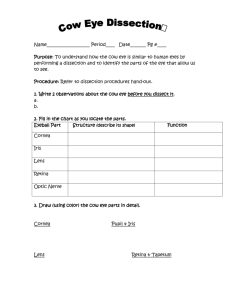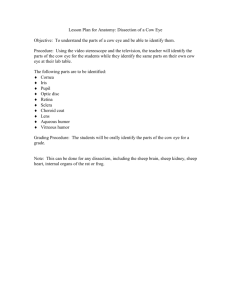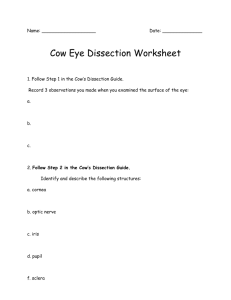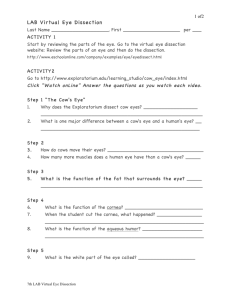Culturally Responsive Optics
advertisement
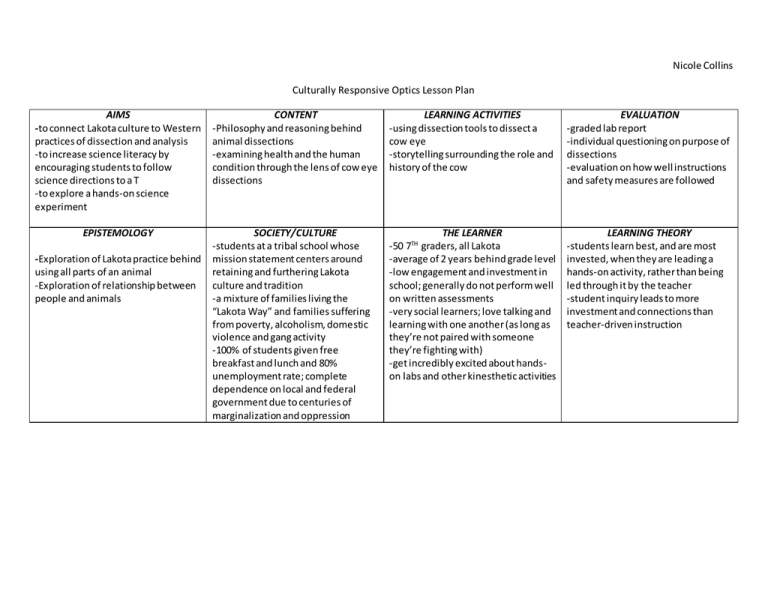
Nicole Collins Culturally Responsive Optics Lesson Plan AIMS -to connect Lakota culture to Western practices of dissection and analysis -to increase science literacy by encouraging students to follow science directions to a T -to explore a hands-on science experiment EPISTEMOLOGY -Exploration of Lakota practice behind using all parts of an animal -Exploration of relationship between people and animals CONTENT -Philosophy and reasoning behind animal dissections -examining health and the human condition through the lens of cow eye dissections LEARNING ACTIVITIES -using dissection tools to dissect a cow eye -storytelling surrounding the role and history of the cow EVALUATION -graded lab report -individual questioning on purpose of dissections -evaluation on how well instructions and safety measures are followed SOCIETY/CULTURE -students at a tribal school whose mission statement centers around retaining and furthering Lakota culture and tradition -a mixture of families living the “Lakota Way” and families suffering from poverty, alcoholism, domestic violence and gang activity -100% of students given free breakfast and lunch and 80% unemployment rate; complete dependence on local and federal government due to centuries of marginalization and oppression THE LEARNER -50 7TH graders, all Lakota -average of 2 years behind grade level -low engagement and investment in school; generally do not perform well on written assessments -very social learners; love talking and learning with one another (as long as they’re not paired with someone they’re fighting with) -get incredibly excited about handson labs and other kinesthetic activities LEARNING THEORY -students learn best, and are most invested, when they are leading a hands-on activity, rather than being led through it by the teacher -student inquiry leads to more investment and connections than teacher-driven instruction ROKET TEK Integrated Lesson Lakota Culture, Optics and Cow Eyes Subject(s): __Life Science_____________________ Grade: ___7__ # of Days:___1__________ Teacher(s): __Nicole Collins___________ School: ____St. Francis Indian School_________________________ LESSON ELEMENT 1. Common Core/Next Generation Learning Standard(s) Addressed: CCSS.ELA-Literacy.RST.6-8.3 Follow precisely a multistep procedure when carrying out experiments, taking measurements, or performing technical tasks. CCSS.ELA-Literacy.RST.6-8.9 Compare and contrast the information gained from experiments, simulations, video, or multimedia sources with that gained from reading a text on the same topic. CCSS.ELA-Literacy.RST.6-8.7 Integrate quantitative or technical information expressed in words in a text with a version of that information expressed visually (e.g., in a flowchart, diagram, model, graph, or table). 2. Learning Target(s): (What will students know & be able to do as a result of this lesson?) TEK Infusion Students will be able to follow a lab procedure to safely and successfully dissect a cow eye. Students will be able to explain the role of dissection within the Lakota context of interrelatedness and wellness. Students will be able to explain basic optical science behind eyes. 3. Relevance/Rationale: (Why are the outcomes of this lesson important in the real world? Why are these outcomes This lesson plan focuses on essential for future learning?) interconnectedness of life, the relationship between humans and The role of animals in science is a hot ethical topic and seemingly faces a conundrum through the lens of animals, and traditional means of Lakota culture and spirituality, which honors and values animals in the web of life. By leading a discussion on why survival. It also explores Lakota scientists use animals in activities like dissections, students will have the chance to critically weigh the pros and philosophy of animal respect and cons of activities taken for granted and apply Lakota philosophy to reach a conclusion regarding animal dissections. reverence. These conversations help affirm students’ Lakota identities. On a more practical level, the number of Native students in science fields, like optics and biology, is absurdly low. By leading them in a hands-on dissection activity, students’ investment in science will grow, preparing them for success in high school, college and graduate school. In addition, dissections offer an exciting opportunity for students to practice following a multistep procedure and creating diagrams and models, which will lead to common core success in science. 4. Formative Assessment Criteria for Success: (How will you & your students know if they have successfully met the outcomes? What specific criteria will be met in a successful product/process? What does success on this lesson’s outcomes look like?) Students will be assessed based on their adherence to following lab safety and procedures, along with their diagrams of cow eyes and conclusion questions, both oral and written, on the optics of the eye. They will also be assessed on their ideas and thoughts during the debate. Students are given multiple chances to express their knowledge and understanding. This series of lesson plans includes debates, pictures, writing and kinesthetic activities. 5. Activities/Tasks: (What learning experiences will students engage in? How will you use these learning experiences or their student products as formative assessment opportunities?) See above. Students will first engage in a conversation/debate about the ethics of animal dissections through the lens of Lakota philosophy. They will then engage in a cow eye dissection (those opposed to it can complete a virtual lab instead) and complete a lab report. Students will be assessed on their contributions to the debate and their completion/thoroughness of the lab report. 6. Resources/Materials: (What texts, digital resources, & materials will be used in this lesson?) Computers, lab notebooks, cow eyes, scalpels, forceps, pins, dissection trays, newspaper clipping 7. Access for All: (How will you ensure that all students have access to and are able to engage appropriately in this lesson? Consider all aspects of student diversity.) Before this lesson, I will lead several lab safety lessons that allow scaffolding up to a cow eye dissection. Students will e ngage in a virtual dissection, dissect an orange, and finally dissect a chicken wing. Students must prove proficiency in these areas before being allowed to participate in the cow eye dissection. This gives me, the teacher, a chance to rectify any major safety violations before this lesson. 8. Modifications/Accommodations: (What curriculum modifications and/or classroom accommodations will you make for Students with Disabilities in your class? Be as specific as possible.) My student on the Autism spectrum will be paired up directly with a paraprofessional to ensure that the student is fully supported throughout all parts of the lesson. My students on reading IEPs will be paired with students who are strong readers but a bit queasy about hands-on dissections. These partnerships will ensure that procedures will be read and followed, and special ed students will still be completely involved in the lab TEK Alignment TEK Introduction(Why is this important to the student and their culture? Use stories, elders, traditional foods/tools, art, music—this should be the WOW factor!) Where are you getting this material? In Lakota culture, the buffalo, or tatanka, is incredibly sacred. Before western colonization, all parts of the buffalo were used, and the relationship between man and buffalo was part of an ecological web of interconnectedness. Now, where buffalo are endangered and meals are no longer dependent around buffalo, the role of animals in Lakota society is tepid and uncertain. A modern issue that students will face throughout their science education and careers is the role of dissections. On one hand, the idea of humans raising animals purely for dissection asserts the philosophy of human dominance over animals, which is antiethical to traditional ecological knowledge. However, these cow eyes were taken from cows that were going to be slaughtered for meat anyway- these dissections, in a twisted way, ensure that all parts of the cow are used! In addition, dissections contribute greatly to academic success, and allow students to examine the interconnectedness of body systems through a kinesthetic means. Students will no doubt have an opinion on the issue, and will get a chance to express their voice while analyzing Lakota tradition through a modern lens. In addition, the eye is an integral part of the nervous system, which works together with other body systems to ensure the continuance of wiconi wakan, or sacred life. By dissecting cow eyes, students will have the chance to explore how one body system depends on another to work, thus driving home Lakota philosophy of Mitakuye Oyasin, or the interrelatedness of life. How can students share other traditional ecological knowledge if they want? During the debate, students can share stories of animal relationships and animal rights; many of my students live on farms and will undoubtedly have opinions on the role and treatment of animals in society. In addition, during the optics mini-lesson, students can share their stories of optical “illusions” (for instance, noticing how fish aren’t where they appear to be while fishing). Which levels of Bloom’s Revised Taxonomy are targeted? Check one or more. Remembering X Analyzing X Understanding X Evaluating X Applying Creating SFIS Middle/High School Weekly Lesson Plans, 2013-2014 School Year Course: 7th grade science Week of: N/A (5 day lesson plan) Teacher: Nicole Collins Materials: Cow eyes, dissection trays, computer access, forceps, scalpels, probes, pins Aligned Standards Covered During the Week: Day One of Week: Date: Lesson Vocabulary: Retina, cornea, Lesson Objectives: SWBAT follow a multistep procedure to dissect a cow eye SWBAT explain, using optics vocabulary, how people see using their eyes SWBAT debate the merits of animal dissection through the lens of Lakota philosophy IEP Modifications: Student on Autism Spectrum scale paired one-on-one with para; students on reading IEPs will have instructions read out loud to them; students with ADHD given frequent breaks Instructional Strategies Used: Debate, virtual dissection, actual dissection Reason for Use: The debate will give students a chance to voice their opinions, a virtual activity will cement their understanding of eye optics and a hands-on activity will invest them in the engineering of a cow eye Prerequisite Knowledge & Skills for today’s lesson: Understanding of the interconnectedness between human body systems. Students should also have experience dissecting oranges and chicken wings. Instructional Practices: (Using Bloom’s Taxonomy) TEACHER WILL DO STUDENTS WILL DO Opening (Anticipatory Set; it hooks the learners) Lesson Delivery to meet the needs of learners (includes modeling) Guided Practice; teacher is up and moving, checking for understanding (whole group or small group) (Day 1) I will capture students’ attention by displaying an optical illusion. I will then lead a brainstorm of what students know about the eye already, and show them a brief video of a cow eye dissection to gather their initial reactions. Students will view the optical illusion and explain how their eyes “tricked” their brain. They will then pair up to complete a KWL chart on the eye. After watching the cow eye dissection, they will record their initial thoughts on why scientists dissect animals, and how they personally feel on the subject. (Day 1 and 2) I will lead the class in engaging in a debate about the role of animal in science. On Day 1, I will lead students in a “graffiti” activity where they circulate the room, looking at the issue of animal dissection through the lens of a brain surgeon, a Lakota medicine man, a teacher, a farmer and an animal rights activist. On Day 2, I will set up desks in a circle and lead students in voicing their opinions and experiences about animals in science Day 1: In small groups, students will read paragraphs debating the pros and cons of animal dissection from different people in Lakota society, and then record these opinions, plus their own, on butcher paper. Their homework assignment will be to go home and ask their parents and grandparents their thoughts. Day 3: I will lead a brief demonstration on concave lenses and how we see objects through them. I will then lead students through the parts of an eye and perform brief CFUs to ensure that they understand the role of each organelle in making sure that the eye works. Day 3: Students will participate in the demonstration and draw parallels between the lenses used and the lenses in an eye. Students will then take notes from an eye Powerpoint and participate in a game where they need to match the function of an eye part with its structure. Day 4: I will lead students to a virtual cow eye dissection website and monitor them as they virtually dissect the eye, identifying the various parts and recording them. Day 4: Students will virtually dissect the eye, sketching the eye and its parts and explaining each organelle’s function in writing or diagrams. Day 2: Students will debate one another on the merits of animal dissection Individual Practice; teacher is up and moving checking for understanding (Differentiation) Lesson Closure; wrap-up the lesson, reflect on learning, set the stage for the next class Day 5: I will set up a “lab day” for students to dissect a cow eye. Day 5: In pairs, students will follow a multistep procedure to dissect the cow eye. They will identify the different parts as they dissect and demonstrate excellent safety and respect procedures. I will ask students to share their final thoughts on the role of animals in science, and lead a group brainstorm on how to maintain the highest amount of respect and dignity for animals during science experiments. After cleaning up, students will share their final thoughts on animal respect and reverence, and write or draw their final thoughts on the issue before handing in their lab reports and heading to the next class.
